Crusty Semolina Bread
This Semolina Bread Recipe produces an artisan loaf with a crisp crust and light, chewy crumb. It is best baked in a Dutch oven, but the recipe is very flexible and adaptable.
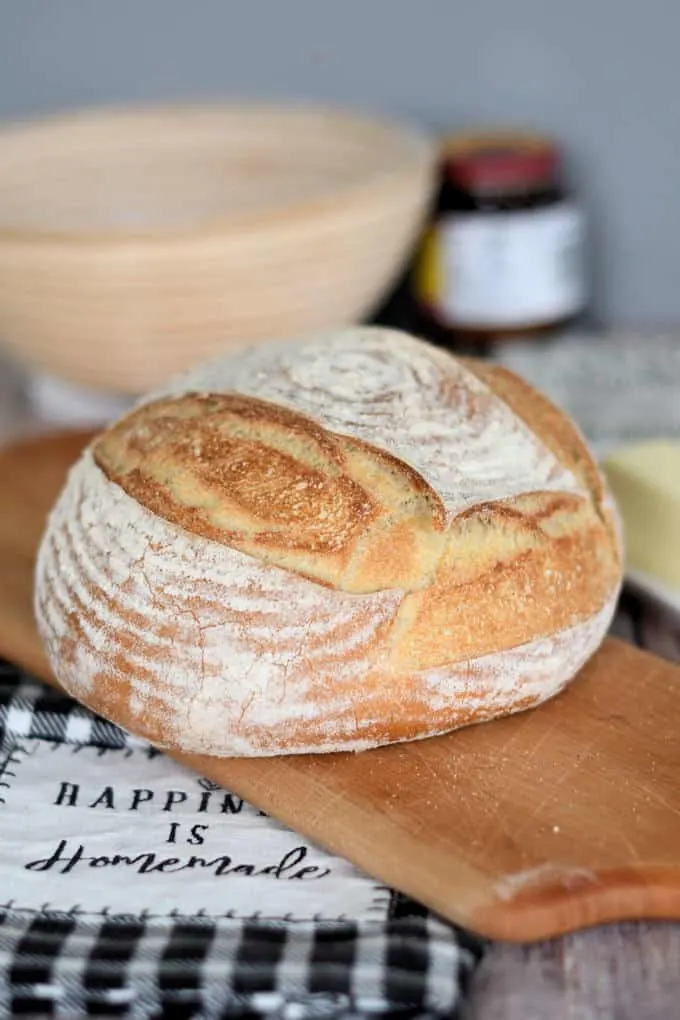
What is semolina flour and is it good for baking bread?
Semolina flour is made from a different strain of wheat than all purpose or bread flour. Semolina is made from Durum, a high protein wheat.
Semolina is the flour used to make pasta. It has a slightly yellow color thanks to the high concentration of carotenoids in the wheat. The carotenoids also add subtle nuttiness that makes for a great tasting loaf of bread.
What does all this mean? High protein plus lovely yellow color plus delicious taste equals a flour is that is perfect for bread baking!
In the market you may see coarsely ground semolina or more finely ground flour labeled “durum” flour. As long as you’re using a product made from durum wheat you’ll make a nice loaf of bread.
How to make Crusty Semolina Bread
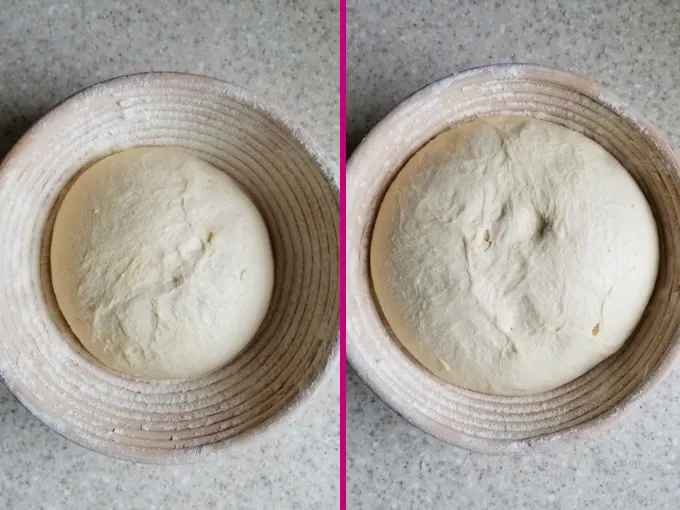
- Place the dough into a bread banneton heavily dusted with Semolina Flour and set it aside to rise for 1 1/2- 2 hours.
- If you don’t have a basket, place the dough on parchment paper or a sheet pan for rising.
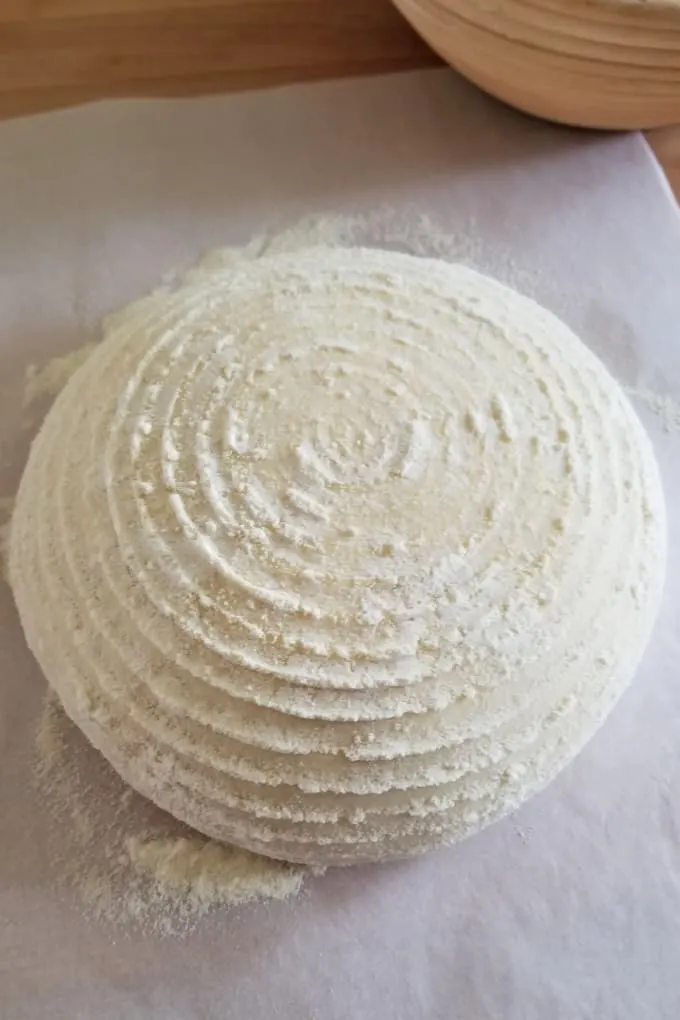
- Flip the loaf onto a sheet of parchment and use the parchment to transfer the loaf to the pre-heated Dutch oven.
- Bake until golden brown and the interior reaches 200F.
Tips for making Semolina Bread:
- You can use either durum semolina or more finely ground durum flour. I made the bread with both with very good results.
- If you have one, use a proofing basket for pretty finish.
- If you have one, use a Dutch oven or other heavy, lidded pot for an extra crisp crust.
- If you don’t have a proofing basket you can proof the dough on a parchment lined sheet pan or on a wooden peel sprinkled with semolina or corn meal.
- If you don’t have a Dutch oven, bake the bread on preheated pizza stone, or on sheet pan.
If you’ve got a Sourdough Starter, try my recipe for Sourdough Semolina Bread.
You might also like these other easy bread recipes: Dutch Tiger Bread, Whole Grain Low Knead Bread, Soft White Sandwich Bread, Overnight Rye Bread, Milk & Honey Whole Wheat Bread and Honey Oatmeal Bread.
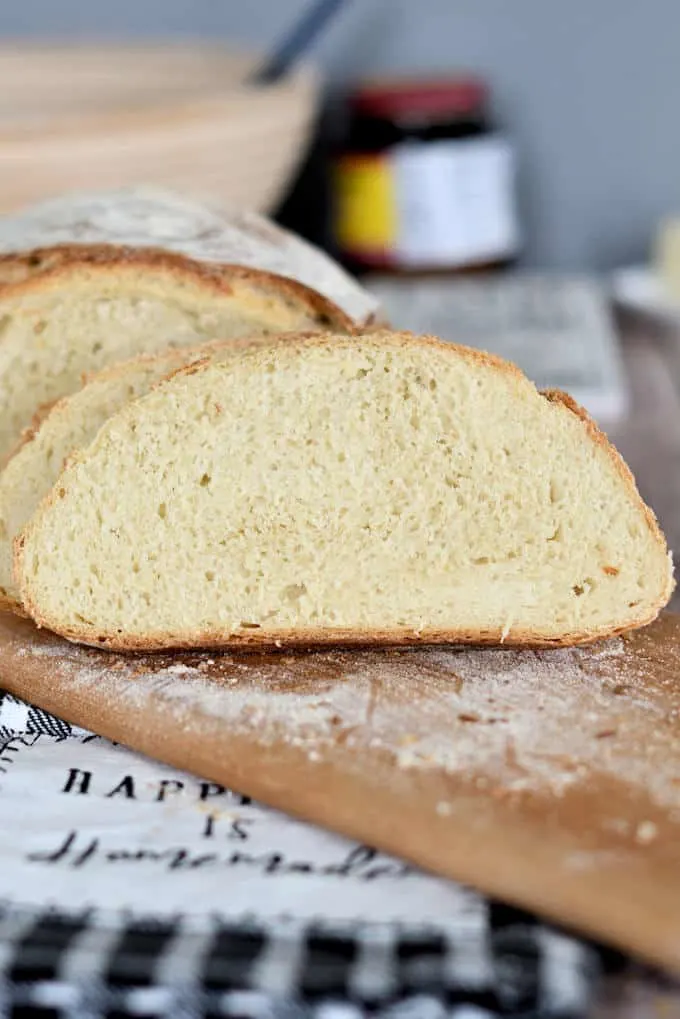
If you love this recipe as much as I do, I’d really appreciate a star rating and a quick comment. Ratings and comments help my recipes show in search results. Thanks!
Semolina Bread Recipe
Ingredients
- 12 oz warm water (1 ½ cups)
- 2 ¼ teaspoons dry yeast (1 packet)
- 11 ¼ oz unbleached all purpose flour (2 ¼ cups, see note)
- 6 ½ oz semolina flour (1 cup)
- 1 ½ teaspoons table salt
Instructions
- In a large mixing bowl or in the bowl of a stand mixer, combine 12 oz warm water, 2 ¼ teaspoons dry yeast and 2 cups of the all purpose flour. Mix with the paddle on low speed until it forms a thick batter. Cover the bowl and set aside for 30 minutes.
- If using a stand mixer, switch to the dough hook. Add 1 ½ teaspoons table salt and 6 ½ oz semolina flour and mix until the dough begins to form a ball around the hook. Add the remaining 1/4 cup of all purpose flour. If mixing by hand add the flour using a wooden spoon and/or a plastic bowl scraper. Knead the dough for 5 minutes until it is smooth and elastic.
- Place the dough into a lightly oiled bowl, turn once to coat the dough. Cover the bowl and set it aside at room temperature for 1 – 1 1/2 hours or until doubled in size. At this point you can cover the bowl tightly, refrigerate overnight and finish shaping and baking in the morning or continue to bake the same day.
- Use the semolina/all purpose mix to dust a proofing basket or wooden peel. Turn the dough out onto a lightly floured surface. Knead 4-5 times, then use your cupped hands to form the dough into a smooth ball and place the dough, smooth side down, into the proofing basket. If you don’t have a proofing basket place the dough directly onto a sheet of parchment paper or on the wooden peel.
- Cover the dough and leave in a warm place until it's almost doubled in size and it springs back slowly when poked, about 1 hour depending on the room temperature and dough temperature. Meanwhile, preheat the oven to 425 °F. Place a Dutch oven with a lid into the oven to preheat.
- If the loaf is in a proofing basket, place a sheet of parchment over the dough and gently flip it over. Use a single edge razor or very sharp knife to cut a 1/4" deep X or square across the top of the loaf. Remove the preheated pan from the oven and remove the lid. Use the parchment to lift the loaf into the Dutch oven. If you don’t have a Dutch oven, slide the parchment paper onto a baking sheet or onto a preheated pizza stone.
- Replace the lid on the pot and slide it into the oven. Bake for 20 minutes. Remove the lid from the Dutch oven. The loaf should be well risen and just beginning to brown.
- Continue baking another 20 minutes until the loaf is nicely browned and beginning to crisp. Remove the pan from the oven. Use the parchment to lift the loaf out of the pan. Use the parchment to place the loaf directly onto the rack in the oven. Bake another 5-10 minutes until the loaf is deeply browned and very crisp. Total baking time is about 40-50 minutes. If you are baking directly on a pizza stone or sheet pan the baking time may be closer to 30 minutes.
- Cool completely on a wire rack before slicing.
Would you like to save this recipe?
As an Amazon Associate and member of other affiliate programs, I earn from qualifying purchases.

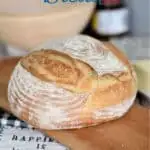
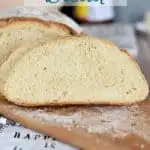
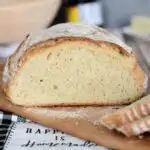




Baked beautifully and a pretty easy recipe!
Very confusing instructions. Please make a step-by-step step tutorial video.
If you have a specific question or further information about where you are confused I’d be happy to help. A step by step video tutorial is a major time commitment. I can’t just whip one up on request.
Love this recipe I have a big family that loves bread how can I double this recipe
The main problem would be the capacity of your mixer. If you’re doing the dough by hand and think you can manage it go ahead and double the recipe. If you’re mixing in a stand mixer you might overheat the mixer with a double batch (unless you have a 6qt mixer). To save time you could measure all the ingredients 2x and mix two batches, one after the other.
I did an almost 24 hour rise in the fridge & the loaf came out fantastic. Crusty outside, chewy inside & delicious. This one’s getting added to the recipe book. Thanks for sharing.
How long are we supposed to mix the flour, yeast, salt, water mixture for? I’m been mixing with the dough hook for 10 minutes and it’s still had a watery consistency. It took adding maybe 2 cups more flour and it still melted of the hook like a thick batter. Any ideas on what’s wrong?
I’m not sure which step you’re asking about. Step 1 for making the sponge says to mix until it forms a thick batter. Basically, mix until it comes together. Step 2 says to knead for 5 minutes. After step 2 when the rest of the flour is added it should come together as a dough. If you are measuring your flour by volume make sure to use the “dip and sweep” method for filling the measuring cup. That is “dip” the cup into the flour bin and overfill it. Then “sweep” away the excess flour. If you lightly spoon the flour into the cup you could end up with less flour than is needed in the recipe.
Why is there no sugar listed to help the yeast proof?
The yeast doesn’t need sugar to proof it’s get plenty of food from the flour.
Delicious. Recipe is pretty easy to follow. A couple of points need more clarity but since it turned out so well, I assume that kneading for five minutes after mixing with dough hook was correct. Still not sure if
I needed to let the dough ferment overnight or not and why.
Yes, knead the dough 5 minutes either by hand or mixer. The recipe is adaptable to your needs and schedule. If you’d like to have fresh bread for lunch it makes sense to start the dough the day before so you can bake in the morning. If you prefer you can start the dough in the morning and bake later in the evening. The longer/cooler rise in the refrigerator overnight does improve the flavor of the bread, but either way the bread tastes great. But the main point is that the recipe is adaptable.
I’m a little confused as I am not a bread baker but my sister and I thought we would try this recipe. I’m confused about the yeast. It says instant yeast should be used, but I thought that instant yeast was used in recipes that you only had one rise. This recipe calls for two. Please could you explain this in laymen’s terms that will clear this confusion up for the future of all my bread recipes? Thanks
Hi Bonnie, I did change the recipe to specify “dry yeast” which is what I usually write. You can use any dry yeast you’ve got on hand. I always do 2 rises for my yeast breads, no matter which yeast I use. Your rising time will vary. There are a lot of different terms and types of yeast out there; instant, rapid, fast, etc. So I just use the generic “dry” yeast.
I made your semolina bread today and it is definitely my new favorite bread! I followed your directions using a Kitchen Aid Mixer, a proofing basket and a Dutch oven. The crust browned beautifully, it is nice and crispy and most delicious!!! I will make this many more times, for sure!
One question: What is the best way to store this crusty bread so that it does not soften overnight?
A paper bag is probably the best way to store the bread overnight.
One cup of flour is 120 grams. 2 1/4 cups of flour is 260 grams, not 315. Same on the semolina…makes a difference!
The weight of a cup of flour is not an absolute or a law of nature. It depends on how you fill the cup. I use the “dip and sweep” method for filling a measuring cup. That is, I dip the cup into the flour bin and overfill. Then I sweep away the excess. If you fluff up the flour and spoon it into the cup you could get as much as 1/2-1 ounce less flour. For all purpose and bread flour I get 5 oz (140g) every time. Semolina flour weighs heavier.
I’m a first time bread baker and I want to try this in my 5-1/2 qt Dutch oven. Is that large enough? Also, can I sprinkle sesame seeds on top?
I baked it in a 7.5 qt Dutch oven with room to spare. As long as the dough fills up less than half the pot it should have room to expand. Yes to sesame seeds!
@Joe C, I mix fennel seeds while kneading , 1 Tsp , the aroma in the bread and the kitchen is heavenly.
Can I use bread flour for this recipe?
I assume you mean bread flour instead of ap flour? Yes, but bread flour will absorb more water than ap flour, so maybe hold back a 1/4 cup or a few tablespoons to check the texture of the dough. You can always sprinkle in the reserved flour if the dough seems too wet.
Can this recipe be adapted for use in a bread machine? I would love to try this out in my new machine! Thank you
I’ve never used a bread machine so I couldn’t say for sure. Anyone else know??
I’m new to bread baking and need to purchase a Dutch oven. I see that there are several sizes available. What is the ideal size for the Semolina Bread recipe? Can’t wait to make my first one!
I have a 7 quart Dutch oven that fits a large loaf perfectly. It’s also a great size for soups and stews.
Love this recipe! Silly question, from a novice….I have a tight fitting plastic lid for my KitchenAid mixing bowl. It starts to bow when I’m doing step one (air buildup). Is that ok? Or is the lid too tightly sealed? Just wondering if I should or should not seal so tightly. Thanks!
A lid with a tight seal is fine. That just means you’ve got plenty of good yeast activity in the sponge. The bowl is covered mostly to prevent the top of the sponge from drying out.
I love this recipe and have made it four times in the past couple of months. My only comment is that it’s a somewhat small loaf! I keep thinking that maybe I’m just not letting the dough rise enough before baking, but on my latest attempt I left it to rise in the warm kitchen for three hours after pulling it out of the fridge and it still made a rather small (probably about 7.5”) round loaf. Is this just a characteristic of semolina flour, or am I doing something wrong? Considering increasing the ingredients by 1.5x next time to see what I get.
This is not a huge loaf. The loaf you see pictured in the post is about 8″ round. That’s the size of my proofing basket so it’s the size of the loaf.
This bread baked up beautifully! During the process I had big doubts….the dough was very sticky. I’m glad I measured carefully and had faith! Best crust I ever created. Ordered proofing basket from Amazon for next time.) Used a dark Dutch Oven, stand mixer and precise measurements (cool New England weather.) I highly recommend this recipe.
Wet dough = great crust and moist crumb!
I am an experienced baker. I have tried your semolina recipe twice. I followed the directions exactly. Both times my bread did not brown at all. I know the yeast was good because I used it in other recipes the same day. What do you think went wrong
Did the bread rise and otherwise bake normally but just didn’t brown well? Did you bake the bread in a Dutch oven? When baking in the Dutch oven I like to remove the bread and put it back in the oven for the last 5 minutes to get a nice brown crust.
Do you use an oven thermometer to verify the internal oven temperature?
I keep an oven thermometer in my oven to monitor oven temp and I use a probe thermometer to check internal temp of the loaf.